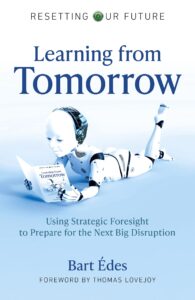The nature of challenges facing governmental organizations has never been more complex, staggering in scope and strategically important. To give governmental organizations every opportunity to successfully prepare, a growing consensus is emerging on the need to do a much better job of anticipating what realities could lie ahead, rather than exclusively planning for current trends and obvious signals. This capability is often referred to as gaining strategic foresight or an ability to “factor in the future” into all strategic deliberations.

To help governmental leaders scale this curve, Bart Édes has published a wonderfully readable and practical book entitled “Learning from Tomorrow.” It includes a fundamental grounding in the nature, benefits, limitations, and optional approaches to gain Foresight. He describes strategic foresight as “a systematic, intelligence-gathering, vision-building process that helps us manage uncertainty by discerning plausible alternative futures and applying the insights to present-day planning.”
We need look no further than our lived experience these past few years to understand how important it is for agency leaders, planners, resource allocators, and rule makers to build their foresight quotient, allowing them to be prepared for tectonic and multi-dimensional disruption that is and will continue to occur.
Highly valuable learning resources included in this short book are a wide range of national and international case studies, a timely glossary of terms, and an impressive bibliography. One specific take-away is a recognition that many high-income countries have used Foresight to prepare for armed conflict, but have not done as well at applying this same set of tools to address more localized or regional concerns, e.g., traffic patterns, immigration, land and water use, and cyber-security.
For large (especially) governmental organizations there is obvious value here. I’m thinking smaller organizations (who cannot afford an in-depth foresight engagement) would gain great value from having their teams explore a small set of the scenarios summarized herein. Even that level of team effort should stimulate a good deal of strategic thinking that will facilitate improved decision-making.
If you find yourself facing one or more strategic concerns, I highly recommend taking time to learn from Bart Édes’ great experience and progressive thought.
